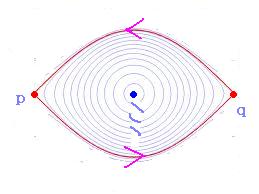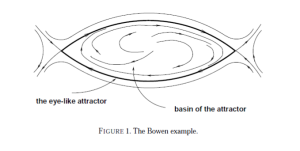4. (Notes from the paper Stable ergodicity for partially hyperbolic attractors with negative central exponents)
Let and
be a partially hyperbolic attractor. Then there exists a
neighborhood
such that every
possesses a partially hyperbolic attractor
near
. Moreover assume
with Gibbs u-states
on
, then any weak limit is a Gibbs u-state on
.
Let be an ergodic Gibbs u-state with negative central Lyapunov exponents. Then there exist an open set
such that
. The analog doesn’t hold for Gibbs u-states with positive central Lyapunov exponents, since the stable and unstable directions play different roles in dissipative systems.
Proof. We build a magnet over
with fiber
. Then every nearby point
with Birkhoff-regular plaque
, the intersection
has positive leaf volume, and some point in there must be Birkhoff-regular, say
for some
. Then Hopf test: for any
,
So all Birkhoff-regular plaques lie in the same ergodic omponent.
Moreover suppose is the unique Gibbs u-state of
. Then there exists a
neighborhood
such that for every
,
possesses a unique Gibbs u-state
. Moreover
has only negative central Lyapunov exponents and
as
. So we say
is stably ergodic. Since all these measures are hyperbolic, further analysis shows that
is indeed stably Bernoulli.
The key property they listed there is: for every , there exists
and
depending continuously of
such that
– for every regular point with
, the frequency of times
such that the size of local Pesin manifolds at
is larger than
is larger than
.
– Moreover, for every ergodic hyperbolic measure with
, theand hence the set
of points with large Pesin manifolds has positive measure: by Kac’s formula,
.
3. In the continued paper here fundamental domains have been found for many invariant subsets, in particular for the set of (Birkhoff) heteroclinic points (see Theorem 3.2 there, where
). It is unknown if the argument can be carried out to the set of (Birkhoff) homoclinic points
(for general invariant but nonergodic measure
). Here is an example where there does exist a fundamental domain. Consider a flow on the plate
with spiraling source
in the center and two saddles
at the corners.
The second picture is from here, and is called Bowen eye-like attractor. Suppose the dynamics is symmetric and for every
, where
is the time-1 map. Then it is easy to see that there exists a fundamental domain
of
. We can blow up the center, identify the corresponding boundaries of two copies and reverse the flow direction on the second copy. Then the subset
turns out to be a fundamental domain of the set of (Birkhoff) homoclinic points
.
2. Let be a
partially hyperbolic diffeomorphism,
be an Absolutely Continuous, Invariant Probability measure. That is, the density function
is well defined in
, and the set
is well defined in the measure-class of
.
It is proved (Proposition 3, here) that is bi-essentially saturated (by a density argument). Similar argument shows that every invariant subset of
is also bi-essentially saturated. At that time I thought the classical Hopf argument can only claim the bi-essential
-saturation of
, and Proposition 3 might be out of the range of Hopf argument. Now it seems this is not the case if we combine some results in Gibbs
-measures, which states, for example, the conditional measures
of
with respect to the unstable foliation
is not only abs. cont., but also smooth: the canonical density (see here)
is Holder, bounded and bounded away from zero, since ACIP is automatically a Gibbs
-measure.
So let be an invariant subset of
. Then Hopf argument implies that
Then a standard argument shows that is essentially
-saturated. Similarly ACIP is automatically a Gibbs
-measure and
is essentially
-saturated. This shows that
is bi-essentially saturated by Hopf argument and Gibbs theory.
1. Let be a plaque of the Pesin unstable manifold of
, and consider a function
with the property that
for all
, and the normalizing condition
. Let
be the induced probability on
. It is conditionally invariant under
: Consider its pushforward
. Then:
for any
. Hence
. In particular
.
Then by definition, both and
induce probabilities and must coincide:
. Such measures are called the leafwise u-Gibbs measures.


You must be logged in to post a comment.